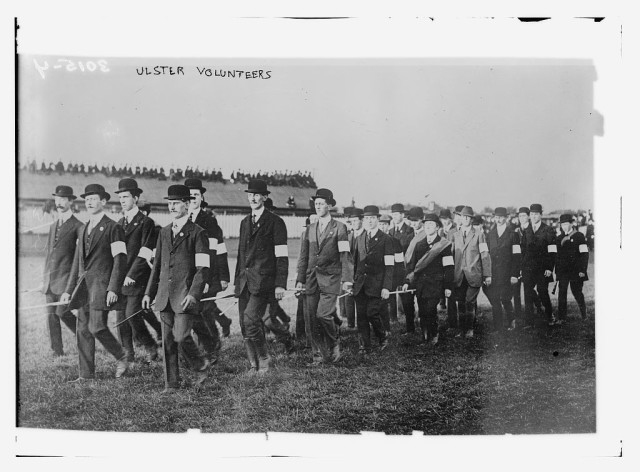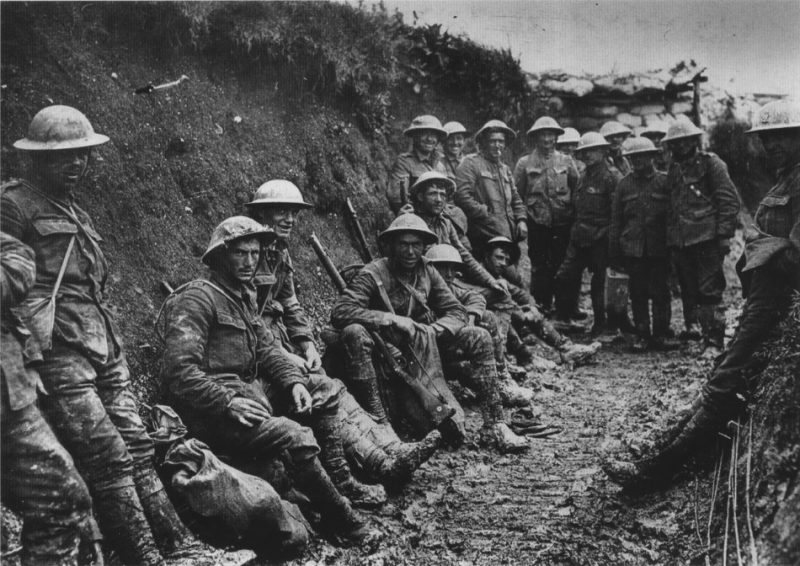Approximately 46,000 volunteers for the British military came from Belfast in World War I. When war,commenced in 1914, it had direct implications for Ireland and the debate over Home Rule.
Unionists found the war to be a reason to suspend action on Home Rule. Nationalists felt that the war provided an opportunity to pressure the government to pass Home Rule as an Act.
In the early weeks of the war, the uncertainty over Home Rule had an effect on recruitment in Ulster. Soon, a truce was reached when Home Rule was passed into law on September 18, 1914, but its implementation was postponed until after the war. A special, undefined provision was included for Ulster.
Unionists were angered by the compromise, but nationalists were thrilled. They could now focus their energies on the war effort.
The first part of recruitment was to call up the reserve. Many members of the Ulster Volunteer Force and Irish Volunteers were also British army reservists and special reservists. They were both mobilized immediately after war was declared. About 3,000 reservists left the Belfast shipyards for active service at this time.
Next, the search for volunteers began. The leaders of each of the political militias offered their services for military duty. Joe Devlin, the Home Rule MP for West Belfast and a director of The Irish News, encouraged his supporters to join an ‘Irish Brigade’ in the form of the 16th (Irish) Division.
The nationalist leaders supported the war to show their maturity following the promised Home Rule legislation and to demonstrate that Irish nationalism could be comfortable within the British Empire.
The unionists, though, saw an opportunity to show their loyalty to the Crown and secure Ulster’s place in the union, which is what they had wanted before the war. The UVF was attractive to the British Army as it provided a ready-made army.
The agreement Edward Carson made with the War Office allowed the UVF units to remain together within an ‘Ulster’ Division. Belfast recruits were the heart of Ulster Division’s strength.
Apart from politics, there were many reasons to enlist. For many recruits, boredom, lack of work and adventure were all more compelling reasons than politics. For example, John Boyd of Belfast joined because his friends had joined and he felt that he should enlist as well.

The middle and upper classes often wanted the chance to prove themselves in the officer class. It would be inaccurate to say that they had no choice but to join for economic reasons.
All recruits shared one thing in common; they all had the mistaken belief that they could make a difference.
Men, and some women, from Belfast, made their way into almost every aspect of war. They were even among the first casualties. Private Hugh Bailie of the 2nd South Lancashire Regiment died in Belgium on August 26, 1914.
Civilians were also affected. Patrick McGinley, a former school teacher in Clonard in west Belfast, and Margaret McClintock, who had left for a fresh start in New York, were each fortunate to survive the sinking of the Lusitania.
Others were finding themselves in strange environments. One unidentified ‘Sinn Féiner’ was found in the ranks of the 36th (Ulster) Division. Wilfred Spender noticed how this ‘Sinn Féiner’ was very open about it and even was audacious enough to apply for leave during the Easter Rising in April of 1916.
“When asked why he joined us, he said that he wanted to fight – he thought it was his duty to do so – but that no Sinn Féiner would dream of joining the nationalists (16th Irish Division). All Sinn Féiners admired the UVF!”
The 36th Ulster and the 16th Irish Divisions were both in their first major engagement of the war at the Somme. Initially conceived as a ‘big push’ that could end the war early, by June 1916, it had become a fight just to keep the Allies in the war after the German attack at Verdun.
On July 1, 1916, on the first day of the battle, the Ulster Division’s objective was to advance towards the village of Thiepval to take a fortified German trench network called the Schwaben Redoubt. They managed their advance shortly before 7:30 a.m. during an intensive artillery barrage.
George Hill of Belfast remembered, “When the barrage lifted on the morning of the 1st we went over the top in waves. We had practiced it when out of the line. Some of the lads had got hold of a football and kicked it ahead, shouting ‘Up the Blues’ or ‘Up the Glens’.”
Initially, the Ulster Division overwhelmed the Germans and claimed their objective. However, they were forced to withdrawal by nightfall. A German corporal named Hinkel poignantly recalled this event: “They retreated in their droves from Schwaben Redoubt. Once again our machine guns chattered away. Once again our rifle barrels glowed red hot. Once again my men were seized by the reckless bravado which had gripped them in the morning. Many an Irish mother’s son lay down to the sleep from which there is no awakening.”
Within the first two days of battle, 5,500 were dead, wounded or missing.
Meanwhile, the 16th (Irish) Division moved into the Somme sector in September. Their objective was to liberate the towns of Guillemont and Ginchy.
The Irish Division was more successful than the Ulsters, having successfully reached their objective. They had 4,330 casualties, of which 1,000 lay dead. The two divisions would incur nearly 10,000 casualties at the Somme. They were part of a wider offensive with men from Belfast figuring in units other than the 16th and 36th.
Finally, the battle reached its end in November 1916. The British had advanced only seven miles.
